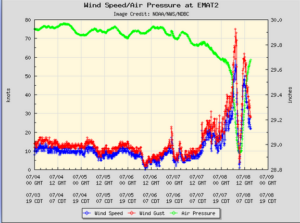Tropical Storm Gordon formed east of the Leeward Islands on Friday morning. At 11:00 a.m. EDT on Friday the center of Tropical Storm Gordon was located at latitude 19.4°N and longitude 38.6°W which put the center about 1640 miles (2650 km) east of the Leeward Islands. Gordon was moving toward the west-northwest at 12 m.p.h. (19 km/h). The maximum sustained wind speed was 40 m.p.h. (65 km/h) and there were wind gusts to 50 m.p.h. (80 km/h). The minimum surface pressure was 1006 mb.
A low pressure system over the Atlantic Ocean between the Leeward Islands and the Cabo Verde Islands strengthened on Friday morning and the U.S. National Hurricane Center designated the system as Tropical Storm Gordon. The distribution of thunderstorms in Gordon’s circulation was asymmetrical. Thunderstorms were occurring in bands in the eastern side of Tropical Storm Gordon. Bands in the western side of Gordon’s circulation consisted primarily of showers and lower clouds.
The distribution of winds speeds around Tropical Storm Gordon was also asymmetrical. Winds to tropical storm force extended out 60 miles (95 km) in the eastern side of Gordon’s circulation. The winds in the western side of Tropical Storm Gordon were blowing at less than tropical storm force.
Tropical Storm Gordon will move through an environment mostly unfavorable for intensification during the next 24 hours. Gordon will move over water where the Sea Surface Temperatures are near 27°C. It will move under the southeastern part of an upper level ridge over the subtropical Atlantic Ocean. The upper level ridge will produce northeasterly winds that will blow toward the top of Gordon’s circulation. Those winds will cause moderate vertical wind shear. Gordon will also move through a region of very dry air. The dry air will make if difficult for new thunderstorms to develop. Tropical Storm Gordon could weaken to a tropical depression during the weekend because of the dry air.
Tropical Storm Gordon will move around the south side of the subtropical high pressure system will steer Gordon to the west during the next 24 hours. On its anticipated track, Tropical Storm Gordon will remain far to the east of the Leeward Islands during the weekend.
Elsewhere, the circulation of former Hurricane Francine was meandering over the Lower Mississippi River Valley. At 11:00 a.m. EDT on Friday the center of Tropical Depression Francine was located at latitude 35.8°N and longitude 91.4°W which put the center about 80 miles (130 km) north-northeast of Little Rock, Arkansas. Francine was moving toward the southeast at 3 m.p.h. (5 km/h). The maximum sustained wind speed was 15 m.p.h. (25 km/h) and there were wind gusts to 25 m.p.h. (40 km/h). The minimum surface pressure was 1005 mb.

